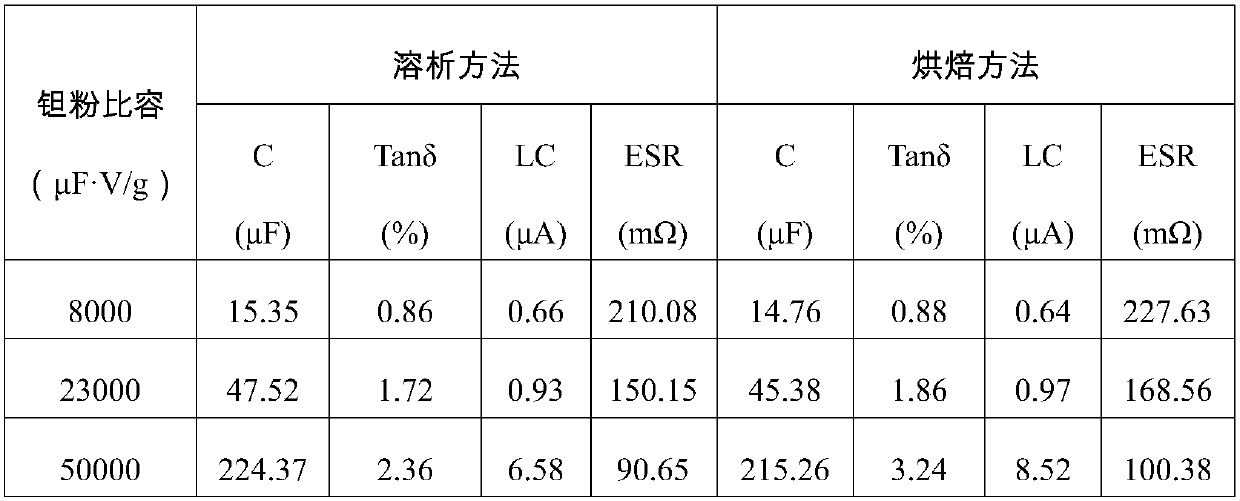A method for removing binder in solid electrolytic capacitor anode block
A solid electrolysis and adhesive technology, which is used in the manufacture of solid electrolytic capacitors, electrolytic capacitors, and electrolytic capacitors, can solve the problems of difficult and clean removal of adhesives, and can improve the capacity extraction rate, improve porosity, The effect of improving stability and reliability
- Summary
- Abstract
- Description
- Claims
- Application Information
AI Technical Summary
Problems solved by technology
Method used
Image
Examples
Embodiment 1
[0031] A method for removing the binder in the anode block of a solid electrolytic capacitor, comprising the following steps:
[0032] (1) Dissolving: mix the adhesive with the solvent and put it in a blender to stir for 2 hours until the adhesive is completely dissolved to obtain a solution;
[0033] (2) Spraying: Spray the solution on the surface of the tantalum powder, and stir while spraying to obtain a mixture;
[0034] (3) Drying: put the mixture in an environment of 20°C and dry for 20 minutes to obtain powder;
[0035] (4) Molding: Pour the powder into a molding machine and press into a molding machine to obtain a tantalum billet;
[0036] (5) Shaking sieve: place the tantalum billet in the sieve and shake it for 3 minutes until there are no particles or dust particles in the sieve;
[0037] (6) The first dissolution: After shaking the sieve, immerse the sieve together with the tantalum billet into the A-type solution for dissolution, and rotate during the dissolutio...
Embodiment 2
[0051] A method for removing the binder in the anode block of a solid electrolytic capacitor, comprising the following steps:
[0052] (1) Dissolving: mix the adhesive with the solvent and put it in a blender to stir for 4 hours until the adhesive is completely dissolved to obtain a solution;
[0053] (2) Spraying: Spray the solution on the surface of the tantalum powder, and stir while spraying to obtain a mixture;
[0054] (3) Drying: put the mixture in an environment of 100°C and dry for 300 minutes to obtain powder;
[0055] (4) Molding: Pour the powder into a molding machine and press into a molding machine to obtain a tantalum billet;
[0056] (5) Shaking sieve: place the tantalum billet in a sieve and shake it for 5 minutes until there are no particles or dust particles in the sieve;
[0057] (6) The first dissolution: After shaking the sieve, immerse the sieve together with the tantalum billet into the A-type solution for dissolution, and rotate during the dissolutio...
Embodiment 3
[0071] A method for removing the binder in the anode block of a solid electrolytic capacitor, comprising the following steps:
[0072] (1) Dissolution: mix the adhesive with the solvent and put it in a blender to stir for 3 hours until the adhesive is completely dissolved to obtain a solution;
[0073] (2) Spraying: Spray the solution on the surface of the tantalum powder, and stir while spraying to obtain a mixture;
[0074] (3) Drying: put the mixture in an environment of 80° C. and dry it for 220 minutes to obtain powder;
[0075] (4) Molding: Pour the powder into a molding machine and press into a molding machine to obtain a tantalum billet;
[0076] (5) Shaking sieve: place the tantalum billet in a sieve and shake it for 4 minutes until there are no particles or dust particles in the sieve;
[0077] (6) The first dissolution: After shaking the sieve, immerse the sieve together with the tantalum billet into the A-type solution for dissolution, and rotate during the disso...
PUM
 Login to View More
Login to View More Abstract
Description
Claims
Application Information
 Login to View More
Login to View More - R&D
- Intellectual Property
- Life Sciences
- Materials
- Tech Scout
- Unparalleled Data Quality
- Higher Quality Content
- 60% Fewer Hallucinations
Browse by: Latest US Patents, China's latest patents, Technical Efficacy Thesaurus, Application Domain, Technology Topic, Popular Technical Reports.
© 2025 PatSnap. All rights reserved.Legal|Privacy policy|Modern Slavery Act Transparency Statement|Sitemap|About US| Contact US: help@patsnap.com

